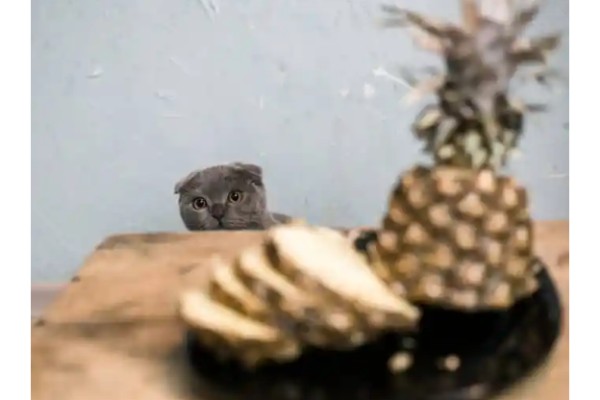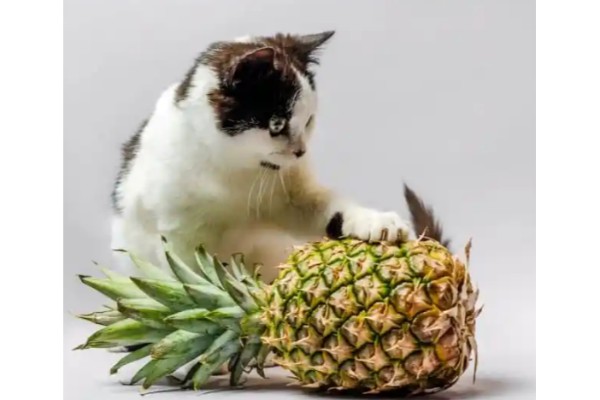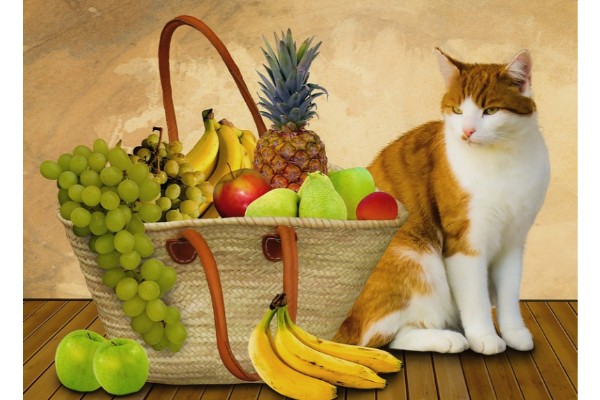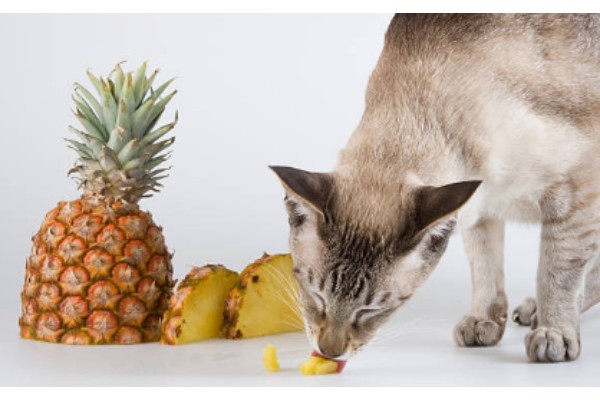Yes, cats can eat pineapples but should only have a small amount of this summer fruit.
Table of Contents
Facts About Pineapples
This tasty fruit, which goes by the scientific name Ananas comosus, is offered everywhere. However, Hawaii is where most pineapples are grown in the United States.
One thing you ought to know about pineapple is that it is actually a berry. The pineapple fruit is made up of individual fruits, over 200 to be exact, just like berries. Because of this, the pineapple is the ideal illustration of a fruit that can be considered as a whole.
The nutritional content of pineapple is abundant, containing high levels of the vitamins C and B complex as well as a number of different minerals, such as manganese, copper, potassium, magnesium, and iron.
Can Cats Eat Pineapple?

It’s likely that you’ve read or heard somewhere that cats should not consume citrus fruits like lemons, oranges, and grapefruits. This is accurate; in fact, every part of these citrus fruits—from the seeds to the skin—is poisonous to cats. Pineapples, how about them?
While the citric acid content of pineapples is relatively high, the citrus fruit family does not include them. Instead, pineapples are tropical fruits and can be safely eaten by your furry pet (cats and dogs included).
This is not the end, though. Even though pineapples aren’t as toxic as lemons, you still need to exercise caution when giving them to your cat.
Your cat should only consume a small amount of this summer fruit, just like with all cat treats and vegetables. Therefore, you should keep that bowl of pineapples out of your cat’s reach.
Can kittens Eat Pineapples?
When kittens are weaned off of solid food, you can occasionally give them pineapple, but it doesn’t contain any essential nutrients. The fruit is not poisonous, but it can be too much for a kitten’s sensitive stomach, leading to vomiting and diarrhea. It’s best to avoid giving your kitten treats because later on, they might start rejecting dry or wet food.
Cat milk is necessary for a kitten’s development, so if the mother isn’t there, don’t give the kitten store-bought milk because that isn’t a good substitute. The best thing to give them is a kitten replacement formula.
Approximately three weeks after birth, your kitten will begin to erupt its first set of teeth. Start introducing them to solid food at this time.
You shouldn’t feed kittens suspect adult cat food because low-quality foods won’t satisfy your kitten’s nutritional needs. Kittens need a high-calorie diet based on animal protein.
Health Benefits Of Pineapple To Cats
Yes, cats can eat pineapple without harm, but do they also get the health benefits that humans do? Can your cats absorb the vitamins and minerals in pineapples given that they are obligate carnivores who rely primarily on meat for survival?
Since their bodies are not designed to process plant matter, cats actually don’t need fruits and vegetables in their diet. However, you don’t have to feel bad about giving in to your cat’s pleading if it’s curious and wants to sample a few bites. Why?
Your feline friend might still benefit from some nutrients even though they are unable to use the majority of them. Here’s a rundown of some of the stuff they can get:
Improve Gut Health
Fiber is known to help humans with digestive problems like constipation. Additionally, it expedites elimination. Cats are the same way.
Hydrating
87% of the weight of this delectable fruit is water. Therefore, giving your cat a small slice or a few pieces of pineapple may help if they are feeling thirsty.
Dangers Of Pineapple To Cats
You must be aware of all potential hazards or negative effects if you want to give your cat some pineapple as a reward or treat.
So, in order to make it simple for all cat owners, we created a list of every risk. We hope that this information will help you and your cat avoid making an otherwise enjoyable situation into a nightmare.
Diarrhea And Other Stomach Problems
The excellent fiber content of pineapple has already been mentioned. As a result of its high fiber content, pineapple can help with digestion but if consumed in excess, it can also lead to diarrhea, vomiting, and other GI problems.
High Levels Of Sugar
The sugar content of pineapples is still significantly higher than that of cantaloupe and papaya, even though it may not be as high as that of grapes and mangoes. Too much pineapple consumption by your pet cat can result in weight gain, diabetes, and dental issues.
Allergy
Pineapple contains an enzyme called actinidin. Fruits like kiwi, mangoes, bananas, and papaya contain the same enzyme. A significant human allergen, actinidin can also cause allergic reactions in some cats.
Apart from actinidin, pineapple also contains bromelain. Although this substance might not be toxic, it can still cause swelling, bleeding, and allergies. Also known to cause allergies is the sap that is found in pineapple leaves.

The Best Way To Serve Pineapple To Your Cat
You want to feed pineapple to your cats, but you don’t want to deal with unpleasant side effects like diarrhea. You can remember the following advice. You can be certain that your cat will enjoy this juicy treat and that there aren’t many risks involved thanks to these.
- You must give your cat a very small amount of any new food when first introducing it to them. This is due to how different each cat’s dietary requirements are. As a result, one cat may consume the food without experiencing any issues while the other cat experiences negative effects.
- Without the core, spiny skin, or pineapple leaves, serve the pineapple. The leaves and other components of pineapples are not poisonous, but they can cause choking.
- Make sure to only give a small amount and cut the flesh into bite-sized pieces. Moderation is key.
- Leave canned pineapple or pineapple juice out of your cat’s diet. These are extremely sweet and contain preservatives.
- Serving the fruit fresh, without any other ingredients, is the best option, so keep it simple. Do not forget that your friend may be harmed by ingredients like salt.
- Give your cat some pieces of frozen pineapple if the weather is extremely hot.
- Providing pineapple as a regular snack or meal for your cat is not advised.
Pineapple Related FAQs
Can Cats Eat Canned Pineapple?
Because the product contains an excessive amount of sugar, you shouldn’t give canned pineapple to your cat. When consumed frequently, canned pineapple may cause cats to develop diabetes, obesity, and dental decay. It may also contain syrup, sugar, preservatives, and artificial flavor enhancers.
When Is Pineapple Bad For Cats?
If given as an occasional treat, feeding cats raw, unsweetened pineapple flesh is generally safe. This could be problematic for your pet’s digestion if given in large quantities. If your cat consumes too much fruit or vegetable, it could cause vomiting and diarrhea.
Pineapple skin and leaves are too tough and difficult to digest for your cat to eat. They run the risk of obstructing your pet’s digestive tract, which would render them severely ill. Due to the tough, rubbery texture of these fruit parts, some cats like to chew on them, but it is best to direct their attention to a cat-safe toy.
Additionally, you should refrain from serving them pineapple that has been cooked in sweet syrups or is part of a decadent dessert like pineapple upside-down cake. These will cause him to eat extra calories, causing him to gain weight, and the high sugar content may make him feel queasy. Similar to how some cats struggle to process lactose (a sugar found in milk), pineapple yogurts and yogurt-coated dried pineapple are not advised.
Do Cats Really Enjoy Pineapple?
While some cats enjoy pineapple, others do not! Due to differences in their taste receptors, cats do not perceive sweet foods in the same way that we do. They might prefer the fruit’s meaty, flesh-like texture, though. Due to the fruit’s high moisture content, they may also find it to be reviving and thirst-quenching.
Out of curiosity, some cats may consume pineapple. Dogs and cats typically have different food preferences, but this isn’t always the case! Just watch out that your cat doesn’t get hurt while exploring and that it only consumes pineapple flesh and not the brittle leaves or skin.
Which Fruit Can Cats Safely Eat?

The fact that cats can eat pineapple has led us to believe that they can eat other fruits as well. Being obligate carnivores, cats do not require fruit in their diet; fruit should only be offered as a special treat. After that, let’s look at some other fruits that your pet can eat without getting sick.
Pomegranates: This fruit has a lot of fiber and vitamin C. You can offer a small amount of food to your cat if it’s curious.
Watermelon: If your cat doesn’t drink a lot of water, giving them watermelon can help them stay hydrated. However, remember to use it sparingly and in small amounts. You should remember to first remove the rind and seeds.
Despite being high in sugar, strawberries are a fruit that is safe for your cat. If you do choose to feed your cat this fruit, do so sparingly and chop it up into manageable pieces first.
Blueberries: Blueberries are healthy for cats and full of antioxidants, but there’s a chance your cat won’t try them because it probably won’t be able to taste them. Blackberries, raspberries, and cranberries are additional options.
Apples: Cats can eat apples without harm, even with the skin on, but first the seeds and stem need to be taken out. Apples are a great source of calcium, vitamin K, and C, all of which are good for your cat’s health.
Mangoes, bananas, kiwis, cantaloupe, and cucumbers are other fruits that your cat may eat in moderation. Remember to only give a small amount of any fruit and to cut it up.
Cat Food Types
There are two popular types of cat food on the market—dry and wet cat food. So that you can decide which is better for your feline friend, let’s examine both.
Dry Food
Since they are the least expensive choice, many cat owners base their feline companions’ diets on cat biscuits. Additionally, some veterinarians assert that this food promotes good oral hygiene. Unfortunately, cat kibble is not the best choice for your cat.
Usually, grains, vegetables, and derivatives of meat are combined to create dry cat food. Whatever nutritional value the inferior ingredients had is typically lost during heavy processing. Low in moisture and high in carbohydrates, the final product. Because of this, eating cat kibble can result in obesity and dehydration.
Senior cats that need to put on weight may benefit from the product, but even then, you should think about combining it with wet food. Your senior will receive a calorie boost and all the necessary nutrients in this way.
Wet Food
The best choice for cats is typically wet food, which typically contains all the vital nutrients cats require to thrive. Your cat will stay hydrated and satisfied because of how moist it is.
Wet food is similar to the natural diet for cats, according to the majority of veterinarians. Wet food will make indoor cats who occasionally hunt mice and insects feel like they are eating fresh prey, so they will enjoy it. Regular servings of wet food will support a cat’s digestive system and metabolism.
We have some advice on how to make the transition from dry to wet food go smoothly if you have a picky cat that won’t eat it. Add some wet food to the kibble mixture along with some soup or broth. As dry food is phased out, start gradually introducing more wet food while reducing the number of biscuits.
